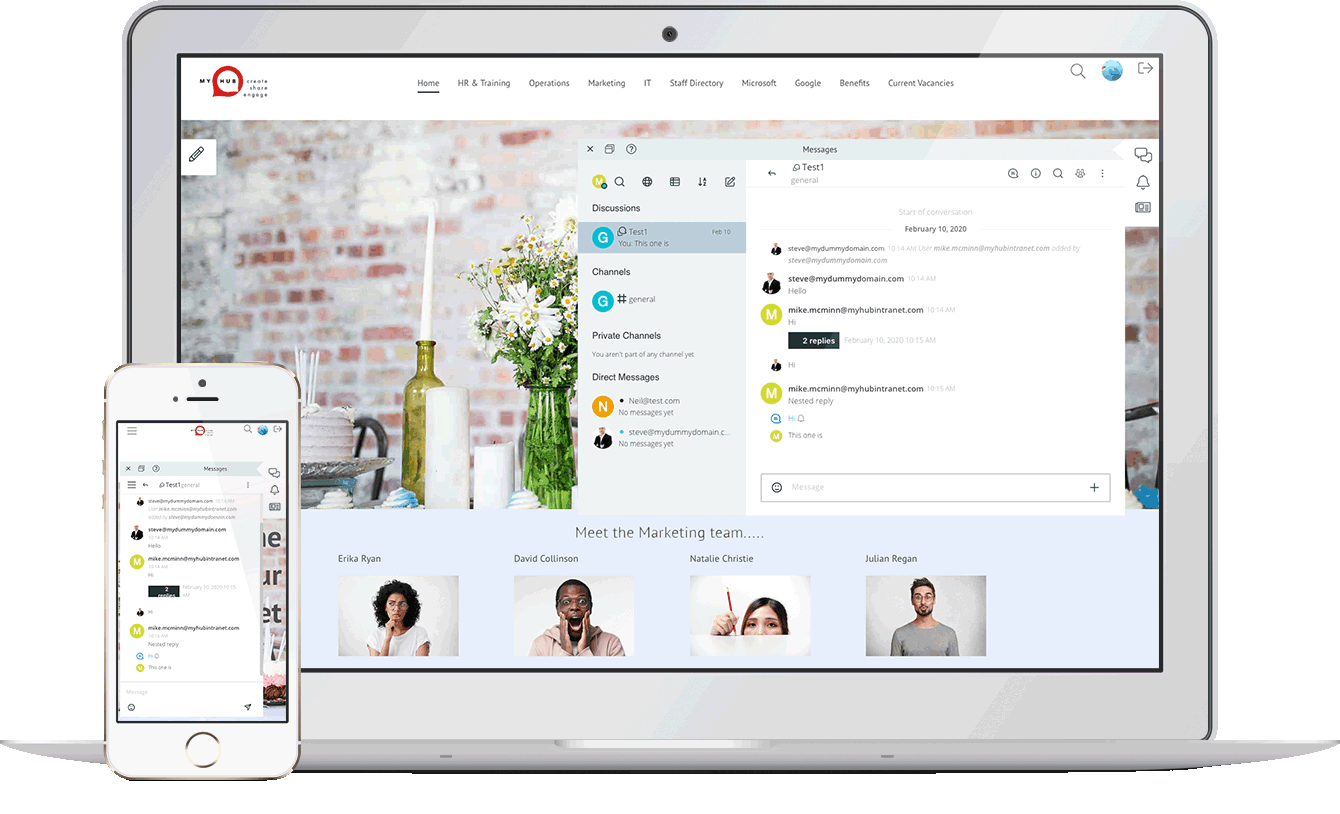Team Collaboration
How To Help Staff Connect, Encourage Ideas, And Move Work Forward
Share. Communicate. Innovate

Team collaboration is a prominent trait among today’s winning organizations. Done right, collaboration aids better decision-making, innovative thinking and improved productivity. Staff are happier, performance is boosted, and there’s less risk of error.
But many organizations have yet to figure out how to help colleagues work better together to achieve a common goal.
The good news is that there are tools and techniques that have proven to nurture a strong collaborative culture within the workplace.
Here, we shed light on the causes of poor collaboration, tips for improvement, and collaboration software that enables co-workers to share ideas and improve internal communications.
What Is Team Collaboration?

The definition of team collaboration is when two or more people work together to achieve a common goal. This is done through idea sharing, planning and executing in unison. In contrast to working on one’s own, team collaboration is regarded as a more productive way to get work done, and carries less risk.
Tackling a major project – such as a new product launch or the introduction of a new internal process – usually requires a teamwork approach. This entails bringing together a group of employees to allocate and complete tasks, within a set timeframe.
These days, with technology overcoming geographical barriers, virtual teams are popular. Companies are now appointing the best people for a project – regardless of their work location – to form part of a team and collaborate. This development has created new opportunities for businesses to innovate – but is not without its challenges.
Why Is Team Collaboration Critical In The 21st Century?

Never before has the workplace been so diverse. For the first time in history, five generations are working side-by-side. Each employee has a unique perspective. Their opinions are formed by their own personal experiences. And they have different communication styles – some prefer face-to-face, others the written word.
Such differences are a lot to manage, particularly when complex, project-based decisions must be made.
How a team interacts with each other will influence the final outcome. Communication, knowledge transfer and equal respect for each team member are essential for a high-performing team.
Younger generations joining the workforce are eager to further develop the collaborative skills they’ve learnt during education. They place place greater support on social tools for collaboration than their older colleagues (49 per cent millennials vs 31 per cent baby boomers). And considering that 46 per cent of 2020’s workforce are millennials (compared with 36 per cent six years ago), employers must act upon this growing generation’s preference for building team dynamics.
Furthermore, around 75% of employees now rate teamwork and collaboration as crucial to their performance.
Reasons For Poor Team Collaboration
It’s a common scenario when a collection of people come together to solve a problem, cross-functionally. There may be representatives in the room from IT, Sales, Product and Finance.
When collaboration fails, it’s often because these individuals partially listen to others points-of-view, but do not fully seek to understand what they were actually saying.
Each representative remains in their own paradigm rather than genuinely taking on board and seeking a solution based on other perspectives.
To counter this, effective collaboration requires recognition of diversity; that each individual has their own thought process and purpose. This requires greater understanding of the team individuals, and the concerns they may be feeling.
These could include the following:
- Skepticism about the success of the project i.e.‘doomed to fail’
- Uncertainty around who does what in the team, and where tasks and responsibilities sit
- Misinterpretation or miscommunication: wrongly assuming all staff have the same understanding
- Lack of direction, KPIs and milestones set out from the start
- Conflicting priorities: failing to appreciate an employee’s current workload before adding more
- Forcing staff to communicate in ways that may be uncomfortable for them i.e. introverted employees making team presentations
How To Improve Team Collaboration
Successful team collaboration is hard work. With so much to consider – silos, company culture, staff at different locations, leadership styles – good team collaboration doesn’t happen by accident.
Furthermore, Harvard Business Review has exposed an interesting paradox at play, based on its research into team behavior:
“Although teams that are large, virtual, diverse, and composed of highly educated specialists are increasingly crucial with challenging projects, those same four characteristics make it hard for teams to get anything done.
“To put it another way, the qualities required for success are the same qualities that undermine success. Members of complex teams are less likely to share knowledge freely, to learn from one another, to shift workloads flexibly to break up unexpected bottlenecks, to help one another complete jobs and meet deadlines, and to share resources.”
It also found that the higher the educational level of the team member, the more challenging collaboration appears for them.
But there are some best practices for building effective collaboration strategies, as follows:
Define And Repeatedly Communicate The Team’s Goals
This is the first step to bringing together a group of people. Goals should be reiterated at the start of daily huddles, referred to when key decisions are underway, and repeated across all communication channels (your intranet, for example).
Promote Open Communication Particularly When Faced With A Roadblock
This is where technology has become a game-changer. Instead of waiting for the next round-table meeting to overcome a roadblock, intranet tools such as forums, instant messaging, and shared files allow members of the same team to work through a problem collaboratively at pace.
Create Structure Within Meetings And Give Staff Time To Prepare
WIP (work-in-progress) meetings are an important part of effective project management. Ahead of each meeting, share agenda items, action lists and related reading material with all members of the team so there are no frustrating delays when teams meet.
Encourage Creativity And Free-thinking: All Ideas To Be Respected
Brainstorming sessions can be fun and fruitful. Team leaders must give advance warning though so staff can do their own research. And if you’re the manager, resist the urge to direct and jump in immediately with your ideas, as staff may feel obliged to follow.
Log Important Decisions And Their Backstory
Avoid the “he said/she said” nature of spontaneous conversations; make sure ideas are contextually documented in a central space, accessible for all, and not lost in the moment.
Invest in Collaboration Tools
Team collaboration tools have shown the way here. Employees can set up team channels where decisions can be made in real-time. Slack, the popular chat tool, has been joined by a host of other instant messaging tools, virtually eliminating the need for traditional email. Video conferencing, in the wake of Covid-19, has become the default meeting format. And forums are another effective channel for effective team collaboration.
Check For Understanding
Nodding heads does not necessarily mean agreement and understanding. Many co-workers won’t like to admit they don’t understand something. Reiterate major decisions – during and after meetings – providing clarity and an opportunity for others to ask further questions. Engage in two-way communication with all members when possible.
Create Ways For Less Outspoken Team Members To Contribute Ideas
Not everyone has public speaking skills. Shy people will not feel comfortable sharing their idea in a room full of colleagues, but may happily submit an idea via a forum or chat channel. Make it known that individual thinking is unique and valued, and that every team member should be able to communicate with equality and authority.
Share Experience, Knowledge And Resources
Use an intranet to capture treasured insights – physically and virtually with file-sharing software. This will save mistakes being repeated, and knowledge walking out the door when someone leaves. Don’t leave this to chance: embed a process for eliciting and storing this valuable intelligence as part of your regular WIP meetings. Add tags to meeting notes that can be searched for later on.
Acknowledge And Celebrate Individual And Team Success
Highlight individual qualities and the special skills that each team member brings to the table. Go big when a milestone or key task has been ticked off with a team building celebration event. This boosts morale and makes people feel valued.
Appoint Task And Relationship-Oriented Leaders
HBR research found that the most productive and innovative teams had leaders who could outline clear goals and responsibilities and easily switch to relationship-building mode i.e. smoothing out internal tensions.
Limit Group Sizes
Not always possible – particularly if you’re about to organize the next Olympics – but aim to keep teams small enough so that staff get to know (and respect) each other, and ideas exchange freely. Big teams tend to be more vulnerable to tunnel vision, or the ‘squeakiest wheel wins’.
❝
Collaborative teams are 5 x higher performing as they feel motivated towards a common goal
Source: i4cp
Team Collaboration Trends
Team Collaboration tools are evolving to suit the changing needs of businesses today.
Flexibility, scalability, and compatibility with existing systems increasingly matter. Because of this, enterprise players such as Cisco, Slack and Microsoft have no choice but to integrate with each other.
Some other noticeable trends in team collaboration include:
Artificial Intelligence
Machine learning tools and bots can help an entire team improve the way they collaborate by making it easier to find information instantly. They can also offer things like real-time translation and transcribing during video conferencing meetings.
Unique Experiences
As more technology vendors come to the integration and interoperability party, open-source platforms with the help of APIs are enabling employers to build their own collaboration experience, just right for their internal culture.
Love Of Video
This format’s popularity continues to rise, but so do expectations around its performance. With remote teams the new normal, businesses are relying more on video conferencing, which must be reliable, secure and consistent.
Team Collaboration Software
Creating a workplace using team collaboration software is a practical move that can really transform how you and your colleagues collaborate.
MyHub’s cloud-based intranet is designed specifically for organizations in search of an affordable and adaptable collaboration solution. It’s fully scalable, designed to support your company’s growth. And fully customizable, to meet your exact needs.
Combining a company internal newsfeed, instant messaging and secure cloud storage, MyHub is the perfect choice for your important projects-in-progress.

Whether you’re an IT pro or completely non-technical, MyHub’s cloud-hosted solution offers all the features and functionality you’ll ever need.
We’ve made it so that it’s super simple to set-up (no coding skills or IT experience required) – and is enjoyable to use!
Using simple drag-and-drop functionality, you can create a professional space for your team to start collaborating in minutes! Being cloud-hosted also means you’re future-proofing your investment: you get to benefit from our latest new features and enhancements as soon as they’re released.
Useful Team Collaboration Resources
CMS Intranet Software: Unleash The Power
In today’s fast-paced business environment, effective internal communication and collaboration are paramount. MyHub’s CMS intranet software offers a comprehensive solution to streamline these processes. By providing a centralized platform for content management, employees can easily create, edit, and share information without the need for extensive technical knowledge. This user-friendly approach ensures that all team members, regardless of their technical expertise, can contribute to and benefit from the intranet’s resources.
The software’s versatility extends beyond content creation. It integrates various tools that facilitate seamless collaboration among team members. Features such as instant messaging, shared calendars, and document sharing enable employees to work together efficiently, regardless of their physical location. This is particularly beneficial for organizations with remote or hybrid work models, as it ensures that all team members remain connected and engaged.
Furthermore, MyHub’s CMS intranet software is designed with scalability in mind. As organizations grow and evolve, the software can be customized to meet changing needs. Whether it’s adding new modules, integrating with other systems, or adjusting user permissions, the platform offers the flexibility required to adapt to an organization’s unique requirements. This scalability ensures that the intranet remains a valuable asset as the organization progresses.
How To Handle Employees With Bad Attitudes: 5 Practical Tips For Managers
Employees with bad attitudes can quietly undermine team morale and productivity, even if they perform their job tasks. These individuals often complain constantly, gossip, shift blame, or subtly resist leadership—behaviors that can poison the work environment if left unchecked. Recognizing the difference between someone occasionally voicing feedback versus someone chronically toxic is vital for managers.
To handle such situations, the article presents five practical strategies. First, document specific instances of negative behavior—unhelpful comments in meetings, undermining coworkers, or undermining authority—so discussions are grounded in fact. Next, have a private meeting (ideally with HR present) where you explain the concern, listen to their perspective, and frame expectations moving forward. From there, co-create an action plan with behavioral benchmarks and follow-up sessions. If the employee fails to change, formal warnings or termination may be necessary.
Beyond direct interventions, the article argues that a positive corporate culture helps deter negative attitudes from arising in the first place. Encouraging two-way communication, recognizing contributions, fostering belonging, caring for employee wellbeing, and celebrating collective wins all help build a resilient, engaged team. The message is clear: dealing with attitude issues early, fairly, and systematically protects team health and long-term performance.
Corporate Communication: What SMEs Need To Know
Effective corporate communication is crucial for SMEs aiming to build strong relationships with both internal and external stakeholders. The article emphasizes that clear and consistent messaging fosters trust, aligns team objectives, and enhances brand reputation. By understanding the nuances of corporate communication, SMEs can navigate challenges and seize opportunities for growth.
The piece delves into the two primary categories of corporate communication: internal and external. Internal communication encompasses interactions within the organization, such as between management and employees or among departments. Tools like intranets, team chats, and internal newsletters can facilitate this. External communication, on the other hand, involves engaging with customers, media, and the public, often through marketing materials, press releases, and social media channels.
To assist SMEs in refining their communication strategies, the article provides practical examples and best practices. It highlights the importance of tailoring messages to the audience, choosing the appropriate communication channels, and maintaining consistency across all platforms. By adopting these practices, SMEs can enhance their corporate communication efforts and achieve greater success in their endeavors.
Overcoming Communication Barriers: Key Skills and Practical Examples
Effective communication is vital for success in any organization. However, various barriers can impede the flow of information, leading to misunderstandings and decreased productivity. These barriers can be physical, such as noise or distance; cultural, like language differences or varying communication styles; or emotional, including fear or lack of trust. Recognizing these obstacles is the first step toward fostering a more communicative and cohesive work environment.
The article delves into specific barriers that organizations often face. For instance, physical barriers may include open office layouts that cause distractions or technological issues that hinder virtual communication. Cultural barriers might involve misinterpretations due to different cultural norms or language proficiency levels. Emotional barriers often stem from unresolved conflicts or lack of psychological safety, which can prevent individuals from expressing themselves openly.
To overcome these challenges, the article suggests several strategies. These include establishing clear communication protocols, promoting cultural awareness and sensitivity, providing training to improve communication skills, and creating an environment where feedback is encouraged and valued. By addressing these barriers proactively, organizations can enhance collaboration, reduce misunderstandings, and improve overall efficiency.
Simplify Project Tracking With 10 Tools That Keep Your Team Aligned
Project tracking is the practice of systematically monitoring the progress of tasks and deliverables against an established plan. By collecting real-time data and comparing it to expectations, project managers can spot delays or resource misalignments early—and take corrective action. This kind of visibility helps keep initiatives on schedule and in scope.
The article emphasizes how lacking clarity or slow internal communications are major contributors to project failures—citing that 39% of projects fail due to ambiguous objectives, and 33% cite communication issues. To tackle such challenges, the post recommends selecting project-tracking tools that centralize task lists, timelines, dependencies, and status updates in one place.
To help readers choose wisely, the article presents 10 tools that can support project tracking and team alignment. It also discusses how intranet-based tracking tools (like MyHub’s modules) can make collaboration smoother by embedding tracking within your internal network—reducing context-switching and improving adoption.
How to Overcome Idea Hoarding: Why Employees Keep Ideas to Themselves
Idea hoarding happens when employees tuck away insights or suggestions instead of sharing them. The article explores key reasons for this behaviour—fear of rejection or negative judgment, unclear or unrewarded submission processes, and lack of recognition. These issues stem from both psychological barriers and organizational design flaws—such as vague follow-up workflows or opaque decision environments.
To counteract idea hoarding, the piece argues for transparent communication. It describes how clear leadership, open decision-making, and regular feedback can create safer environments in which employees feel their contributions matter. This transparency isn’t just philosophy—it’s backed up by intranet platforms that make idea submission visible, let employees track the progress of their ideas, and offer forums or boards where ideas can be discussed openly.
Finally, it offers practical steps for organisations aiming to foster openness: establish clear idea submission rules; provide visible dashboards showing what ideas have been submitted and what stage of review they are in; showcase employee contributions; hold “open decision” or feedback sessions; and measure outcomes like number of ideas submitted, rate of implementation, and employee satisfaction related to being heard. These actions can remove friction, build trust, and improve engagement.





